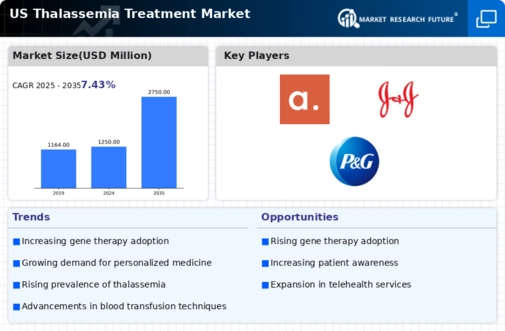Rising Prevalence of Thalassemia
The increasing prevalence of thalassemia in the US is a critical driver for the thalassemia treatment market. According to the Centers for Disease Control and Prevention (CDC), thalassemia affects approximately 1 in 100,000 individuals in the US, with higher rates observed in certain ethnic groups. This growing patient population necessitates the development and availability of effective treatment options. As awareness of the disease rises, healthcare providers are more likely to screen for thalassemia, leading to earlier diagnosis and intervention. Consequently, this trend is expected to boost demand for therapies, including blood transfusions, iron chelation therapy, and emerging gene therapies. the thalassemia treatment market is poised for growth as healthcare systems adapt to meet the needs of this expanding demographic.
Advancements in Treatment Technologies
Technological advancements in the thalassemia treatment market are transforming patient care and outcomes. Innovations such as gene therapy and novel drug formulations are emerging, offering new hope for patients. For instance, recent developments in gene editing techniques, like CRISPR, have shown promise in correcting genetic mutations responsible for thalassemia. The potential for curative therapies is driving investment in research and development, with funding from both public and private sectors. In 2025, the market for gene therapies is projected to reach $5 billion, reflecting a growing interest in these advanced treatment modalities. As these technologies become more accessible, they are likely to reshape the landscape of the thalassemia treatment market, providing patients with more effective and personalized options.
Increased Government Support and Funding
Government support plays a pivotal role in the growth of the thalassemia treatment market. In recent years, federal and state initiatives have focused on enhancing research funding and improving access to care for patients with thalassemia. The National Institutes of Health (NIH) has allocated substantial resources towards thalassemia research, which has led to breakthroughs in treatment options. Additionally, public health campaigns aimed at raising awareness about thalassemia are likely to encourage early diagnosis and treatment. This increased funding and support from government entities may lead to a more robust healthcare infrastructure, ultimately benefiting patients and healthcare providers alike. As a result, the thalassemia treatment market is expected to grow, driven by these supportive measures.
Growing Awareness and Education Initiatives
The rise in awareness and education initiatives surrounding thalassemia is significantly impacting the treatment market. Non-profit organizations and healthcare providers are actively working to educate the public about the disease, its symptoms, and available treatment options. This increased awareness is likely to lead to higher rates of diagnosis and treatment adherence among patients. In 2025, it is estimated that educational programs could increase patient engagement by up to 30%, thereby driving demand for therapies in the thalassemia treatment market. Furthermore, as more individuals become informed about their health, they may seek out specialized care, further propelling market growth. The emphasis on education is thus a vital component in shaping the future of thalassemia treatment.
Emerging Collaborative Research Partnerships
Collaborative research partnerships are emerging as a key driver in the thalassemia treatment market. Academic institutions, pharmaceutical companies, and healthcare organizations are increasingly joining forces to accelerate research and development efforts. These collaborations facilitate the sharing of knowledge, resources, and expertise, which can lead to innovative treatment solutions. For instance, partnerships focused on clinical trials for new therapies are likely to enhance the speed and efficiency of bringing new treatments to market. In 2025, it is projected that collaborative research initiatives could account for over 40% of new drug approvals in the thalassemia treatment market. This trend underscores the importance of teamwork in addressing the complexities of thalassemia and improving patient outcomes.














Leave a Comment